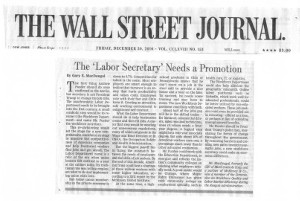The Wall Street Journal
Dec. 29, 2016 6:21 p.m. ET
By GARY E. MACDOUGAL
 The first thing Andrew Puzder should do once confirmed as the next labor secretary is ask President Trump to change his job title. The anachronistic Labor Department needs to be brought into the 21st century. A small symbolic step would be to rename it the Workforce Department—and make Mr. Puzder the workforce secretary.
The first thing Andrew Puzder should do once confirmed as the next labor secretary is ask President Trump to change his job title. The anachronistic Labor Department needs to be brought into the 21st century. A small symbolic step would be to rename it the Workforce Department—and make Mr. Puzder the workforce secretary.
This re-christening would set the stage for a new comprehensive workforce strategy to improve the competitiveness of American companies and help frustrated workers find jobs and get ahead. The Labor Department name is a relic of the era when union leaders felt entitled to a seat at the cabinet table. Its traditional role was telling employers what to do and implementing union wish lists.
But today union membership in the private economy is down to 6.7%. Competition for talent is the norm. Most employers are smart enough to realize that turnover is an enemy that hurts productivity and raises costs. Employees vote with their feet and CEOs know it. Creating an attractive, safe working environment is enlightened self-interest.
What the Labor Department should do is help businesses create and then fill jobs. A major first step would be weeding out unnecessary regulations, many of which originate in its Wage and Hour Division or in OSHA, the Occupation Safety and Health Administration.
But the biggest payoff lies in fixing the mismatch between the needs of employers and the skills of job seekers. By the end of this decade, American firms could face a shortage of three million workers with some higher education, according to a 2011 report by the McKinsey Global Institute.
At the same time, a high-school graduate in Ohio or Pennsylvania knows that he can’t count on a job in the steel mill to provide a nice house and a boat on the lake. To succeed, he needs some training and may have to move. The new Workforce Department could help with both.
About half of the jobs gap will be in the skilled trades—for instance, commercial drivers, sales reps and technicians, none of whom needs a four-year degree. A logical step might be a two-year associate degree, but only about 10% of American workers earn one, a percentage much lower than in other advanced economies.
Mr. Puzder could work with the Education Department, to energize and refocus the nation’s community colleges on teaching what employers actually need. A good model would be Chicago, where Mayor Rahm Emmanuel has given each community college an employment specialty, such as health care, IT, or logistics.
The Workforce Department could also help alleviate the geographic mismatch. Online talent platforms such as LinkedIn, which work well for educated professionals, could be better utilized by less-educated workers. These job seekers could even be provided aid in relocating—offered as a loan, or perhaps in lieu of extending unemployment benefits.
Mr. Puzder should be President Trump’s point man, marshaling the forces of change throughout the government. By removing barriers and creating new paths toward meaningful jobs, a new workforce secretary could make an enormous difference.
Mr. MacDougal, formerly the CEO of Mark Controls Corp. and a partner of McKinsey & Co., was a member of the Commission on Workforce Quality and Labor Market Efficiency during the Reagan administration.